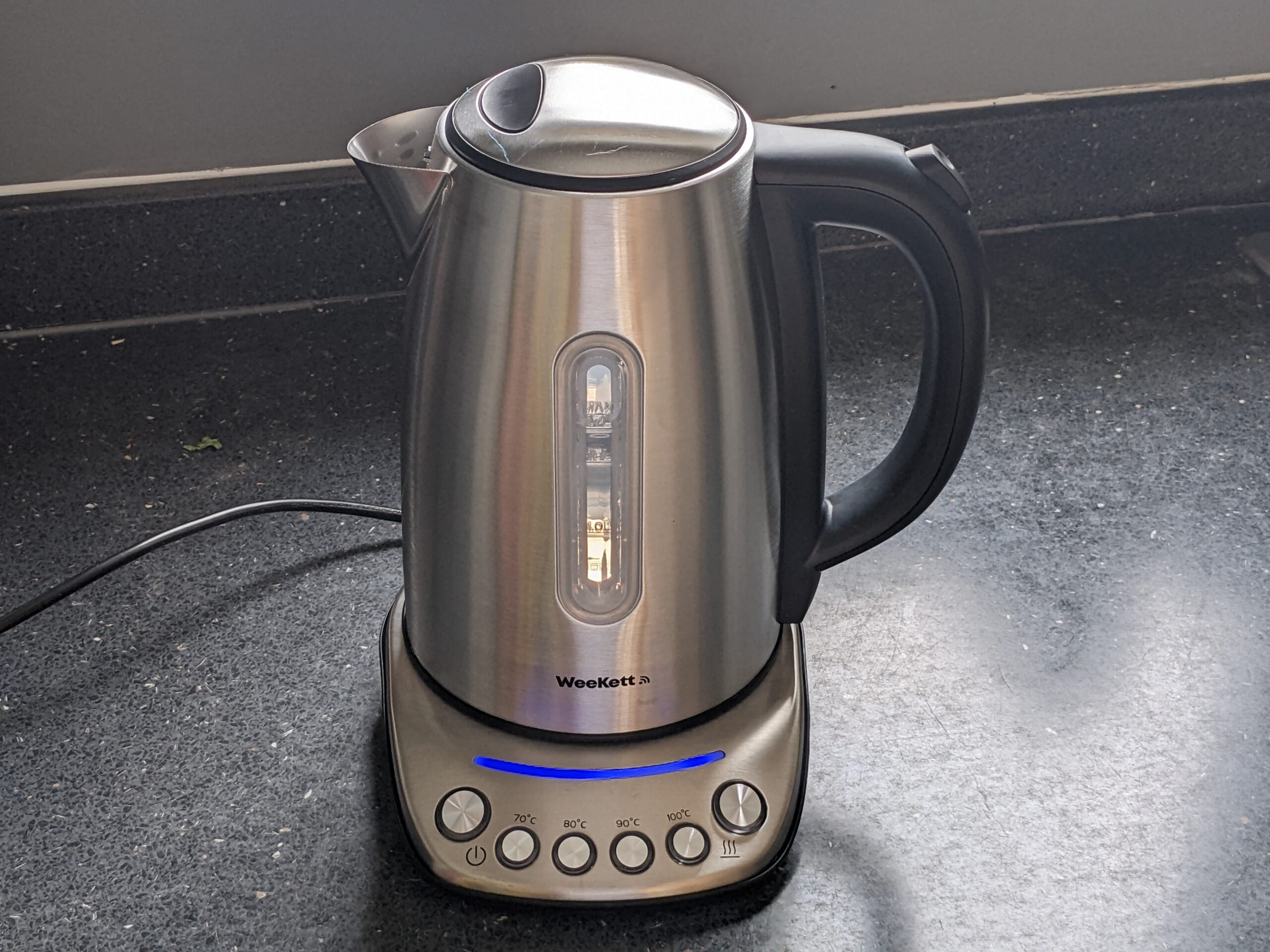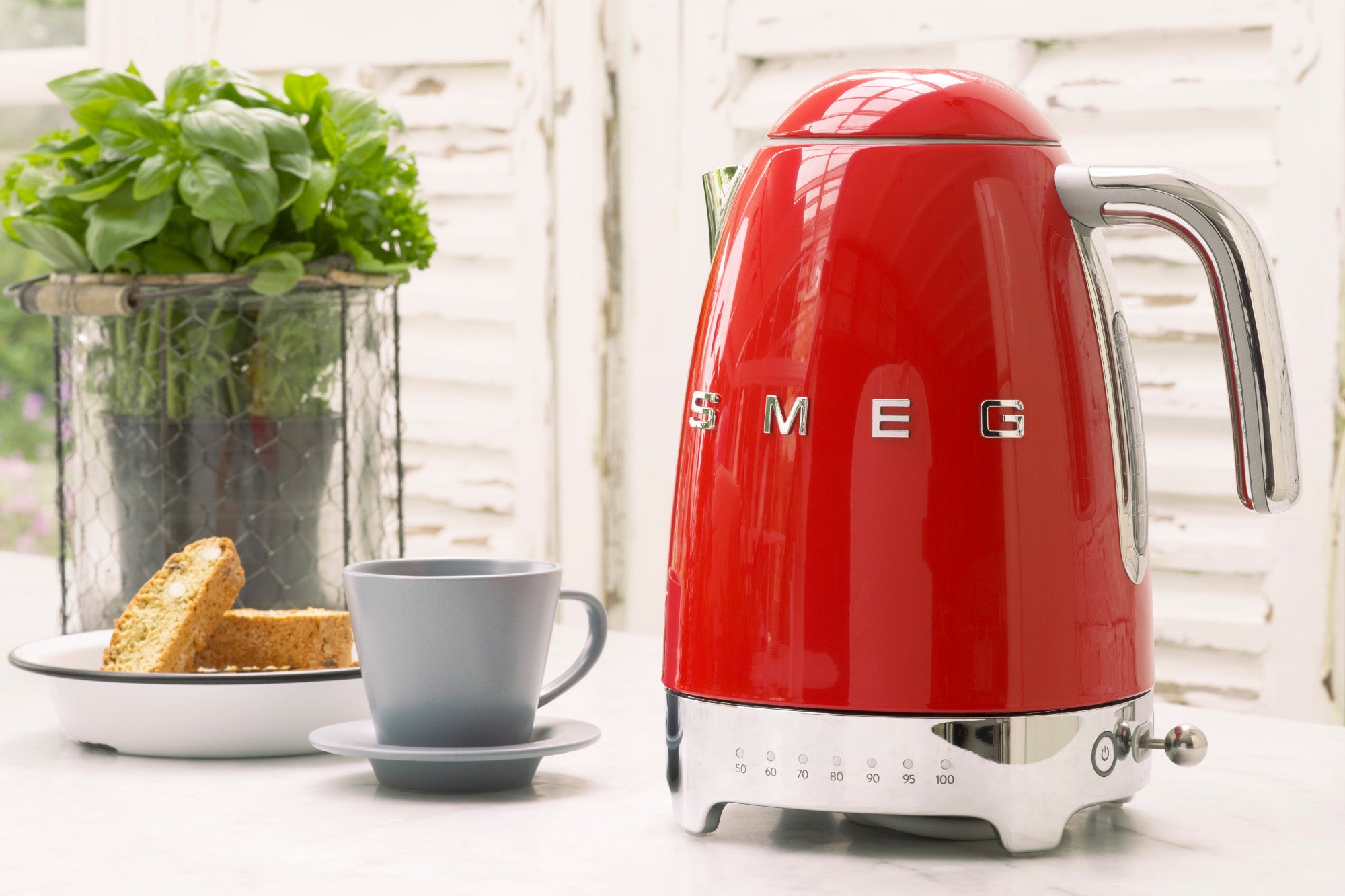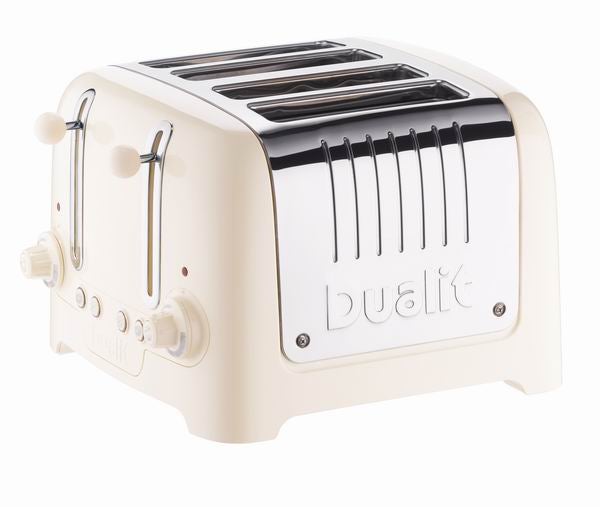Verdict
The WeeKett Smart Wi-Fi Kettle is out to prove that kettles are better with smart controls. The jury may be out on that, but the good news is that even without them, this is a decent multi-temperature kettle for less than you might expect.
Pros
- Reasonably quick and efficient
- Smart steel finish
- Dual water gauges
Cons
- Could be a little more practical
- Can be a very messy pourer
Availability
- UKRRP: £95
- USAunavailable
- Europeunavailable
- Canadaunavailable
- Australiaunavailable
Introduction
WeeKett’s Smart Wi-Fi Kettle is a multi-temperature modern jug kettle with a difference. As well as direct controls, it can hook up with the Samsung SmartThings app, enabling a range of smarter scenarios, including voice control. But even without its smart features, it’s a promising-looking device with some useful talents.
Design and Features
- Reasonably stylish
- Two water gauges
- Smart controls
This is a 1.7-litre kettle, with a minimum boil of 500ml. It has clear plastic water gauges on either side, covering both left and right-handed users. Unfortunately, these only offer litres, rather than cups, and they’re marked with mouldings rather than paint, so they can be a little hard to see. I also noticed the gauge over-reported the fill level, suggesting nearer 1.6 litres when the kettle was filled with exactly 1.5 litres.
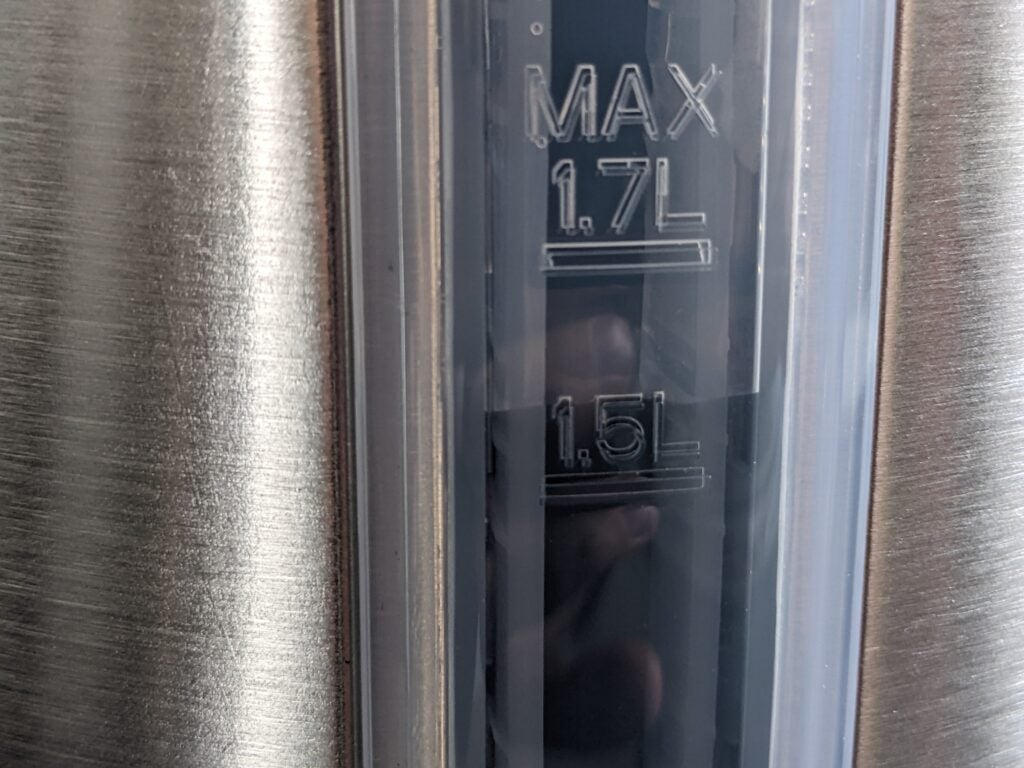
The WeeKett Smart Wi-Fi Kettle has a fine mesh limescale filter in its spout, and a button on the handle releases its lid. This isn’t quite in the perfect place, but it’s not too hard to operate with your thumb.
Pour gently, and you’ll get a consistent stream of water, but tip it up too much and water will escape over the top of the filter and spatter. If you’re too aggressive with a full kettle, water will even run backwards down the outside in surprising volumes – it’s important to use caution if you’re, say, filling a saucepan for pasta.
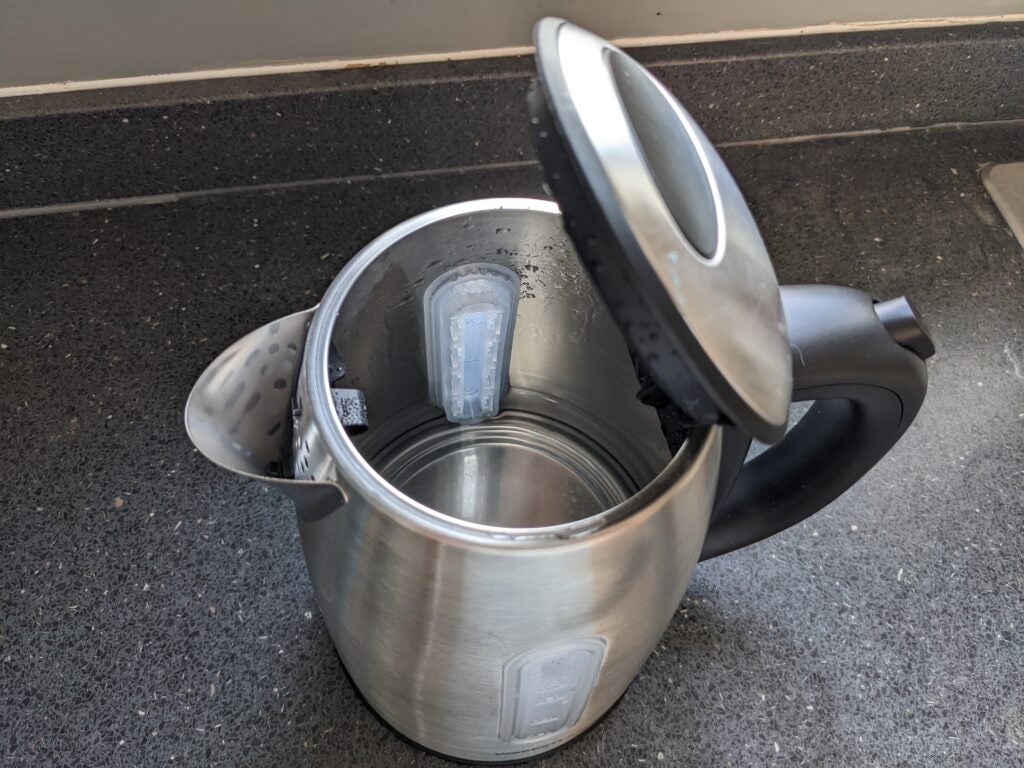
Like many multi-temperature kettles, the WeeKett’s base has a small control panel. There are buttons for 70℃, 80℃, 90℃ and 100℃, as well as ones to start boiling and to keep the water warm. Press the power button, and the kettle defaults to a full boil, but if you need to, you can select a target temperature first. Unfortunately, there’s no Baby Feed button – you’ll need the app for that.
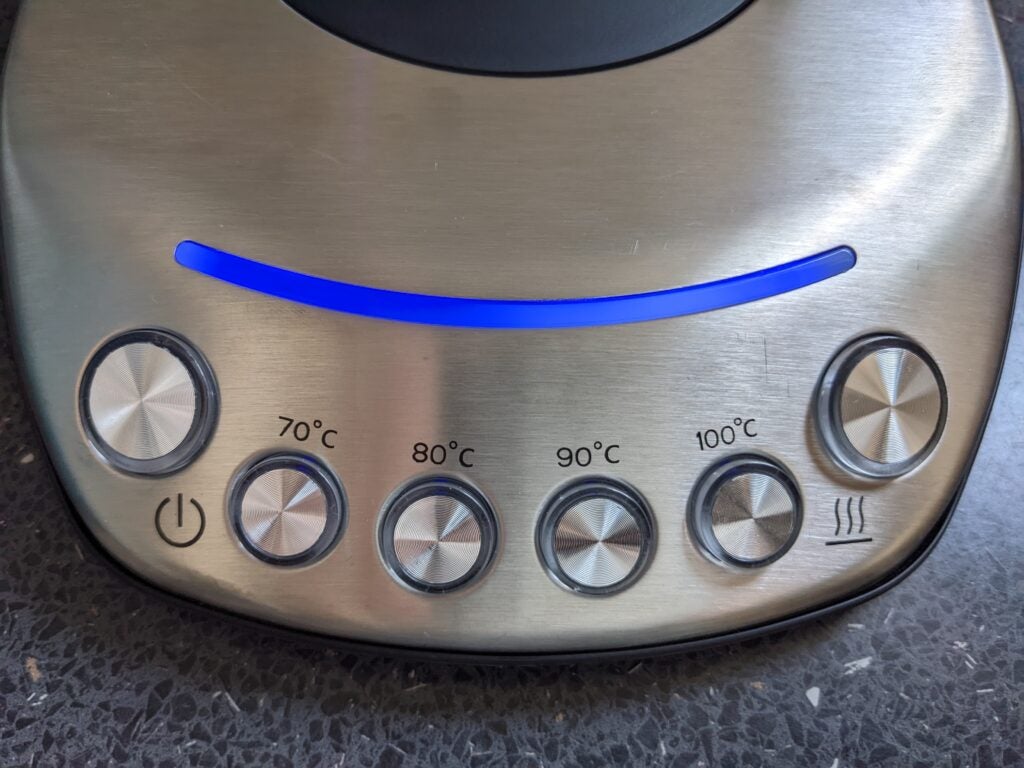
If you’re wondering whether something as simple as a kettle needs smart controls, you’re probably not alone. It’s hard to give a definitive answer, but it’s helpful to look at what’s possible. Once it’s hooked up to SmartThings, you can use the app to activate the keep-warm and Baby Bottle features or to select any target temperature in 1℃ increments, from 40℃ to 100℃. While that is more fine-grained than you get from the physical controls, most users will be happy enough with the base’s 10℃ intervals.
SmartThings’ scheduling features might be of more use. There, you can create one-off, repeat or regular programmes to heat water with whatever settings you need. For example, you could set a weekday boil for the same time as your alarm, with the keep-warm feature on, ensuring that you’ll eventually stumble downstairs to freshly boiled water.
The app also supports voice control through Alexa or Google Assistant, allowing you to give instructions, such as “heat the kettle to 40℃” – which I would have found invaluable when bottle feeding my infant children in the dead of night. This feature could be useful for those with impaired mobility, too. However, as with any delayed or remote activation, you do need to remember to leave water in the kettle. Fortunately, there’s boil-dry protection in case you forget.
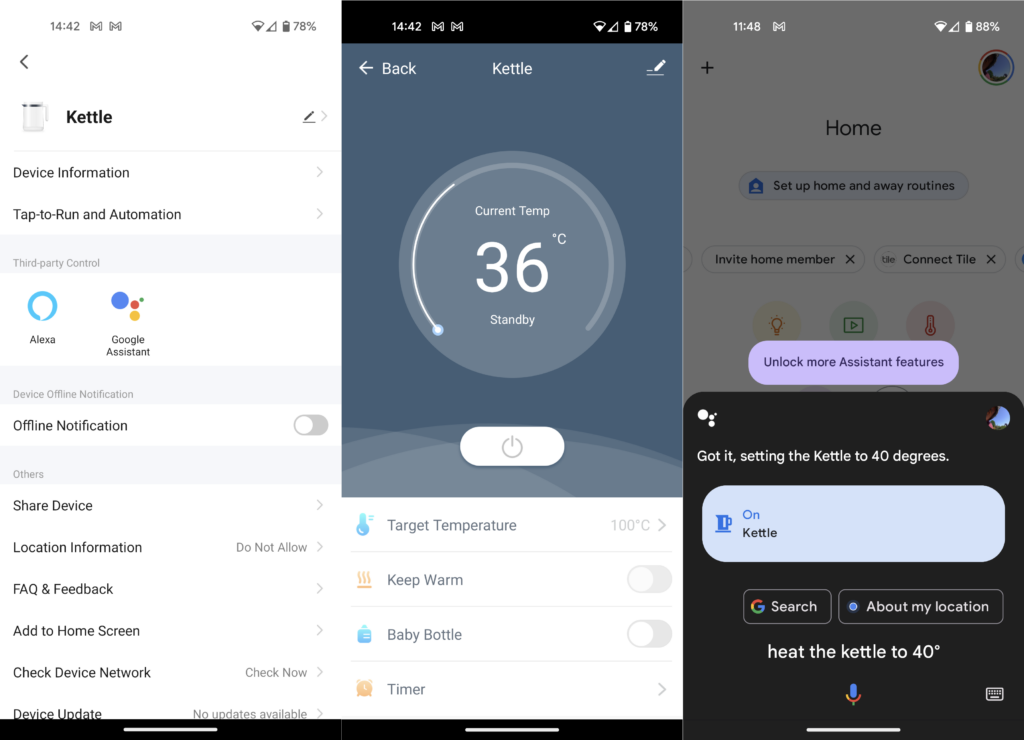
The WeeKett Smart Wi-Fi Kettle offers two modes for connecting to your network. I couldn’t get the Quick mode to work, but the Slow mode operated seamlessly, and it didn’t take long at all.
Performance
- Not the fastest to boil
- Relatively efficient
- Good keep-warm performance
The WeeKett Smart Wi-Fi Kettle has a modest 2.2kW heating element, while the fastest kettles are usually nearer 3kW. Accordingly, it’s slower than some others, but it still managed to boil 500ml of room-temperature water in 1min 40secs – only about 20-30secs behind the quickest I’ve tested. Filled with 1.5 litres, it needed 4mins 25secs to hit a full boil. That’s about 1min behind the fastest.
Kettles don’t tend to vary by much when it comes to power use, regardless of their speed, but the WeeKett is on the efficient side. The smaller boil consumed 0.06kWh, while the bigger one needed 0.15kWh. Those are equal to the lowest figures I’ve measured. Boil 500ml five times a day and, at today’s 34p per kWh cap, you’ll pay just over £35 a year, saving around £7 compared with the least efficient kettle I’ve tested.
When first plugged in and negotiating my Wi-Fi, this kettle’s base consumed 1.7W, but within a few seconds, this had dropped below the 0.1W minimum for my power meter. This suggests that the WeeKett’s standby power use is essentially negligible.
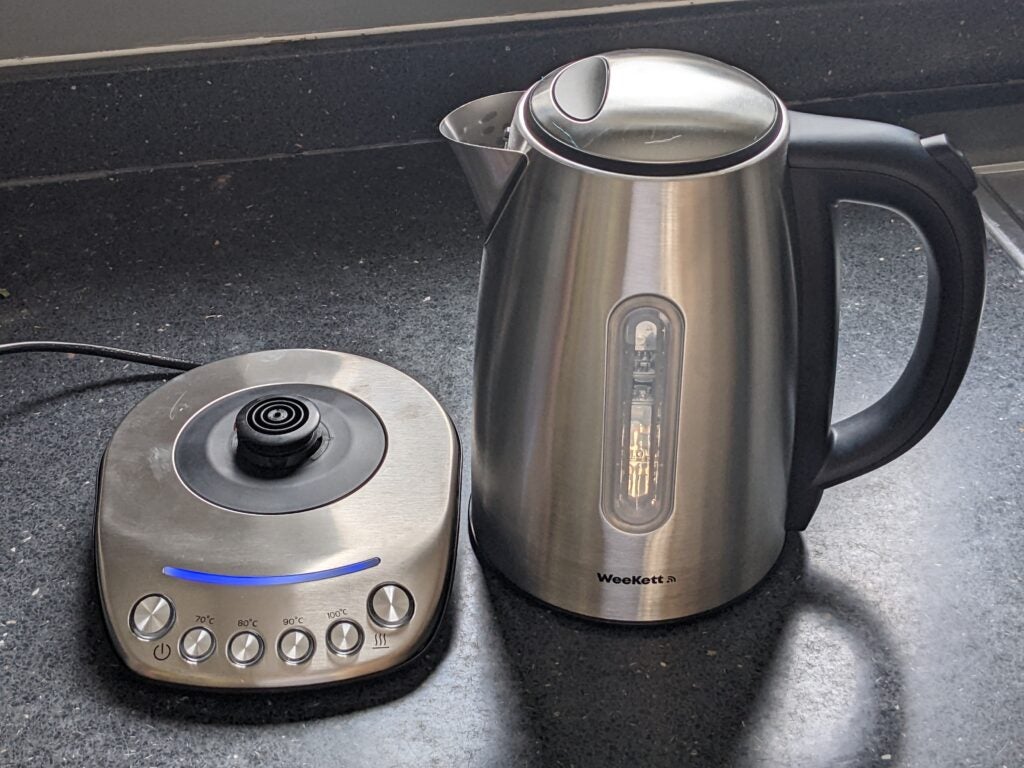
Finally, it’s worth measuring how well a kettle retains its heat – as you’ll pay less to reboil water if it hasn’t cooled down by much. One hour after boiling, 500ml of water had cooled to 54.5℃ and 1.5 litres to 73.7℃ – both significantly warmer than typical for plastic or painted metal kettles, which is a good thing.
Latest Deals
Should you buy it?
If you want a smart kettle, there’s little competition. Happily, this is a decent multi-temperature kettle anyway.
The WeeKett is keenly priced for a multi-temperature kettle, but there’s little point in having smart features if you won’t use them.
Final Thoughts
Even if you don’t want a kettle with smart features, the WeeKett is worth a look. It’s reasonably attractive and offers multiple temperatures and a keep-warm mode – not at all bad at this price. It’s only really let down by a couple of rough edges: notably, some messy pouring and gauges that could be clearer. Some users might benefit from its well-implemented smart controls, however, and here it faces little competition.
If you do want a smart kettle, the WeeKett is a clear winner. If you can live without a smart app, the similarly priced Ninja Perfect Temperature Kettle KT200UK has a wider range of temperature options, selectable from the base. Our guide to the best kettles also has other alternatives.
How we test
Unlike other sites, we test every kettle we review thoroughly over an extended period of time. We use standard tests to compare features properly. We’ll always tell you what we find. We never, ever, accept money to review a product.
Find out more about how we test in our ethics policy.
We use it as our main kettle for the review period.
We measure the temperature of the water for different settings and see how well-insulated each kettle is by measuring a litre of boiled water after 20mins.
We boil one litre of water to see how fast the kettle is.
FAQs
A better question would be whether you need smart controls on a kettle. We can think of several scenarios where they’d be useful, particularly for people with mobility problems or young children. If you can’t think of a use for them, you probably don’t need them.
No. You can plug this kettle in and use the controls on the base. These cover heating water to 70℃, 80℃, 90℃ or 100℃ and include a keep-warm feature.
We’re generally a bit wary about using smart controls on powerful products. That said, the WeeKett has boil-dry protection, so even if you forget to fill it, it should cut out before it causes any harm.
It largely depends on what you drink. Black tea should always be brewed with boiling water, but at 100℃, the flavour of instant and filter coffees will be spoiled. Ideally, you want 90-95℃ for filter and 80℃ or so for instant coffee. Green and other speciality teas might need water heated to only 60℃ or 70℃. Not only will they taste better if you have a multi-temperature kettle, but you’ll also save money by not bringing the water to a full boil.
Sustainability
TrustedReviews’ holds the fact that global warming is not a myth as a core value and will continuously endeavor to help protect our planet from harm in its business practices.
As part of this mission, whenever we review a product we send the company a series of questions to help us gauge and make transparent the impact the device has on the environment.
We currently haven’t received answers to the questions on this product, but will update this page the moment we do. You can see a detailed breakdown of the questions we ask and why in our sustainability info page.
Verdict
The WeeKett Smart Wi-Fi Kettle is out to prove that kettles are better with smart controls. The jury may be out on that, but the good news is that even without them, this is a decent multi-temperature kettle for less than you might expect.
Pros
- Reasonably quick and efficient
- Smart steel finish
- Dual water gauges
Cons
- Could be a little more practical
- Can be a very messy pourer
Availability
- UKRRP: £95
- USAunavailable
- Europeunavailable
- Canadaunavailable
- Australiaunavailable
Introduction
WeeKett’s Smart Wi-Fi Kettle is a multi-temperature modern jug kettle with a difference. As well as direct controls, it can hook up with the Samsung SmartThings app, enabling a range of smarter scenarios, including voice control. But even without its smart features, it’s a promising-looking device with some useful talents.
Design and Features
- Reasonably stylish
- Two water gauges
- Smart controls
This is a 1.7-litre kettle, with a minimum boil of 500ml. It has clear plastic water gauges on either side, covering both left and right-handed users. Unfortunately, these only offer litres, rather than cups, and they’re marked with mouldings rather than paint, so they can be a little hard to see. I also noticed the gauge over-reported the fill level, suggesting nearer 1.6 litres when the kettle was filled with exactly 1.5 litres.

The WeeKett Smart Wi-Fi Kettle has a fine mesh limescale filter in its spout, and a button on the handle releases its lid. This isn’t quite in the perfect place, but it’s not too hard to operate with your thumb.
Pour gently, and you’ll get a consistent stream of water, but tip it up too much and water will escape over the top of the filter and spatter. If you’re too aggressive with a full kettle, water will even run backwards down the outside in surprising volumes – it’s important to use caution if you’re, say, filling a saucepan for pasta.

Like many multi-temperature kettles, the WeeKett’s base has a small control panel. There are buttons for 70℃, 80℃, 90℃ and 100℃, as well as ones to start boiling and to keep the water warm. Press the power button, and the kettle defaults to a full boil, but if you need to, you can select a target temperature first. Unfortunately, there’s no Baby Feed button – you’ll need the app for that.

If you’re wondering whether something as simple as a kettle needs smart controls, you’re probably not alone. It’s hard to give a definitive answer, but it’s helpful to look at what’s possible. Once it’s hooked up to SmartThings, you can use the app to activate the keep-warm and Baby Bottle features or to select any target temperature in 1℃ increments, from 40℃ to 100℃. While that is more fine-grained than you get from the physical controls, most users will be happy enough with the base’s 10℃ intervals.
SmartThings’ scheduling features might be of more use. There, you can create one-off, repeat or regular programmes to heat water with whatever settings you need. For example, you could set a weekday boil for the same time as your alarm, with the keep-warm feature on, ensuring that you’ll eventually stumble downstairs to freshly boiled water.
The app also supports voice control through Alexa or Google Assistant, allowing you to give instructions, such as “heat the kettle to 40℃” – which I would have found invaluable when bottle feeding my infant children in the dead of night. This feature could be useful for those with impaired mobility, too. However, as with any delayed or remote activation, you do need to remember to leave water in the kettle. Fortunately, there’s boil-dry protection in case you forget.

The WeeKett Smart Wi-Fi Kettle offers two modes for connecting to your network. I couldn’t get the Quick mode to work, but the Slow mode operated seamlessly, and it didn’t take long at all.
Performance
- Not the fastest to boil
- Relatively efficient
- Good keep-warm performance
The WeeKett Smart Wi-Fi Kettle has a modest 2.2kW heating element, while the fastest kettles are usually nearer 3kW. Accordingly, it’s slower than some others, but it still managed to boil 500ml of room-temperature water in 1min 40secs – only about 20-30secs behind the quickest I’ve tested. Filled with 1.5 litres, it needed 4mins 25secs to hit a full boil. That’s about 1min behind the fastest.
Kettles don’t tend to vary by much when it comes to power use, regardless of their speed, but the WeeKett is on the efficient side. The smaller boil consumed 0.06kWh, while the bigger one needed 0.15kWh. Those are equal to the lowest figures I’ve measured. Boil 500ml five times a day and, at today’s 34p per kWh cap, you’ll pay just over £35 a year, saving around £7 compared with the least efficient kettle I’ve tested.
When first plugged in and negotiating my Wi-Fi, this kettle’s base consumed 1.7W, but within a few seconds, this had dropped below the 0.1W minimum for my power meter. This suggests that the WeeKett’s standby power use is essentially negligible.

Finally, it’s worth measuring how well a kettle retains its heat – as you’ll pay less to reboil water if it hasn’t cooled down by much. One hour after boiling, 500ml of water had cooled to 54.5℃ and 1.5 litres to 73.7℃ – both significantly warmer than typical for plastic or painted metal kettles, which is a good thing.
Latest Deals
Should you buy it?
If you want a smart kettle, there’s little competition. Happily, this is a decent multi-temperature kettle anyway.
The WeeKett is keenly priced for a multi-temperature kettle, but there’s little point in having smart features if you won’t use them.
Final Thoughts
Even if you don’t want a kettle with smart features, the WeeKett is worth a look. It’s reasonably attractive and offers multiple temperatures and a keep-warm mode – not at all bad at this price. It’s only really let down by a couple of rough edges: notably, some messy pouring and gauges that could be clearer. Some users might benefit from its well-implemented smart controls, however, and here it faces little competition.
If you do want a smart kettle, the WeeKett is a clear winner. If you can live without a smart app, the similarly priced Ninja Perfect Temperature Kettle KT200UK has a wider range of temperature options, selectable from the base. Our guide to the best kettles also has other alternatives.
How we test
Unlike other sites, we test every kettle we review thoroughly over an extended period of time. We use standard tests to compare features properly. We’ll always tell you what we find. We never, ever, accept money to review a product.
Find out more about how we test in our ethics policy.
We use it as our main kettle for the review period.
We measure the temperature of the water for different settings and see how well-insulated each kettle is by measuring a litre of boiled water after 20mins.
We boil one litre of water to see how fast the kettle is.
FAQs
A better question would be whether you need smart controls on a kettle. We can think of several scenarios where they’d be useful, particularly for people with mobility problems or young children. If you can’t think of a use for them, you probably don’t need them.
No. You can plug this kettle in and use the controls on the base. These cover heating water to 70℃, 80℃, 90℃ or 100℃ and include a keep-warm feature.
We’re generally a bit wary about using smart controls on powerful products. That said, the WeeKett has boil-dry protection, so even if you forget to fill it, it should cut out before it causes any harm.
It largely depends on what you drink. Black tea should always be brewed with boiling water, but at 100℃, the flavour of instant and filter coffees will be spoiled. Ideally, you want 90-95℃ for filter and 80℃ or so for instant coffee. Green and other speciality teas might need water heated to only 60℃ or 70℃. Not only will they taste better if you have a multi-temperature kettle, but you’ll also save money by not bringing the water to a full boil.
Sustainability
TrustedReviews’ holds the fact that global warming is not a myth as a core value and will continuously endeavor to help protect our planet from harm in its business practices.
As part of this mission, whenever we review a product we send the company a series of questions to help us gauge and make transparent the impact the device has on the environment.
We currently haven’t received answers to the questions on this product, but will update this page the moment we do. You can see a detailed breakdown of the questions we ask and why in our sustainability info page.



















